|
|
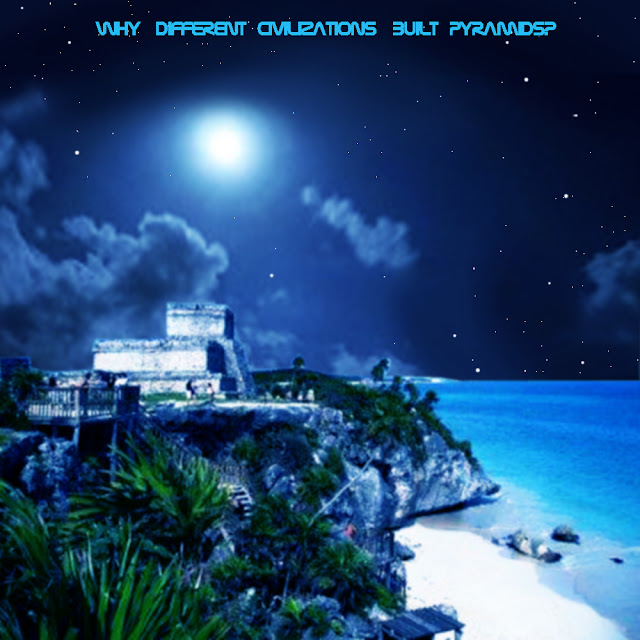 |
| The seaside view of El Castillo at Tulum |
For thousands of years, the largest structures on Earth were pyramids: the Great Pyramid of Khufu in Egypt, is the only one of the Seven Wonders of the Ancient World still remaining.
Pyramids are being constructed since Upper Paleolithic, about 45,000-10,000 years ago to modern days. The first humans used mammoths’ bones, stones and/or pieces of wood as construction material for their pyramid-like structures.
Pyramids are the most stable constructions, and man learned how to imprint some information on it, writing on its walls, or even by the way they’ve constructed it.
Why were pyramids built?
Basically, ancient Egypt pyramids came from the mastabas, tombs used for the burials of pharaohs and their queens.
The first pyramid was made by stacking a mastaba on top of a slightly larger one. Mastabas were relatively low, rectangular, flat-roofed, roughly bench-shaped burial mounds for the pre-Dynastic pharaohs or nobility. Mastabas, which were made of mud brick or stone, were visible monuments, with the actual burial chamber under ground.
During the fourth dynasty, after the construction of the first pyramid, monuments were erected as a signal of prosperity. Tall, glorious, and expensive structures were built as a testament to the society that they represented, and also the rulers who lead those societies. In Egypt, pyramids were erected as a tribute to the glory of the civilization by the Nile.
Pyramids were also related to the religion of the time, Egyptian pyramids held many personal items of the deceased in preparation for his afterlife.
Some other structures in Central America were used as astronomical observatories and benchmarks.
Many have said that some pyramids are mathematical compendium incorporating all kinds of astronomical and cosmological formulas of each civilization.
Although many of these factual findings and conclusions are related to pseudoscientific research, we may consider formulas incorporated in pyramids as "intentional”.
Contrary to common beliefs, the largest pyramid by volume is not the Great Pyramid of Giza; it is the Cholula pyramid in the state of Puebla.

Known as Tlachihualtepetl (Nahuatl for "artificial mountain"), Cholula is a huge complex located in Mexico. Is the largest archaeological site of a pyramid (temple) in the New World. The pyramid stands 55 meters (180 ft) above the surrounding plain, and in its final form it measured 400 by 400 meters (1,300 by 1,300 ft). The pyramid is a temple that has traditionally been viewed as having been dedicated to the god Quetzalcoatl. The architectural style of the building was closely linked to that of Teotihuacan in the Valley of Mexico.
But of course, Egyptians achieved State-of-the art in matters of pyramids construction.
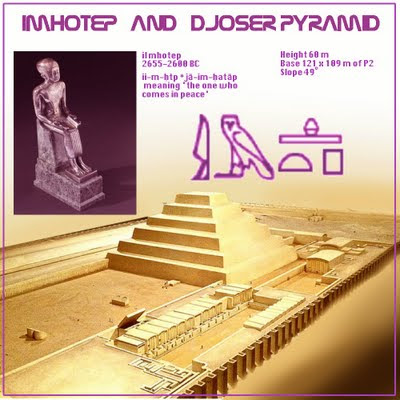 The name behind the construction of the first pyramid was Imhotep, a priest and physician; credited with many miraculous healings.Although he achieved great fame during his lifetime, Imhotep's renown continued to grow after his death. He eventually achieved status of a god among Egyptians.He is best known today as the architect who began the "age of pyramids" in Egypt. He designed and supervised the building of the step pyramid complex at Saqqara, which is believed to be the first colossal stone edifice ever built, but ancient Egypt’s chief attraction still the Great Pyramid of Giza.It has been said that the dimensions of the Great Pyramid of Giza incorporate measurements from which the Earth's size and shape can be calculated, as well as the distance between the Earth and the moon and the distance between the Earth and the sun.The Great Pyramid of Giza, also called Khufu’s Pyramid or Cheops was built entirely of limestone, and is considered an architectural masterpiece. It contains around 1,300,000 blocks ranging in weight from 2.5 tons to 15 tons and is built on a square base with sides measuring about 230 m (755 ft), covering 13 acres. Its four sides face the four cardinal points precisely and it has an angle of about 51 degrees. The original height of the Pyramid was c.146.5 m (488 ft), but today it is only 137 m (455 ft) high, the 9 m (33 ft) that is missing is due to the theft of the fine quality limestone covering, or casing stones to build houses and Mosques in Cairo.Find here some nice statistics about the Pyramid of Khufu:- The sides of all three of the Giza pyramids were astronomically oriented to be north-south and east-west within a small fraction of a degree; The name behind the construction of the first pyramid was Imhotep, a priest and physician; credited with many miraculous healings.Although he achieved great fame during his lifetime, Imhotep's renown continued to grow after his death. He eventually achieved status of a god among Egyptians.He is best known today as the architect who began the "age of pyramids" in Egypt. He designed and supervised the building of the step pyramid complex at Saqqara, which is believed to be the first colossal stone edifice ever built, but ancient Egypt’s chief attraction still the Great Pyramid of Giza.It has been said that the dimensions of the Great Pyramid of Giza incorporate measurements from which the Earth's size and shape can be calculated, as well as the distance between the Earth and the moon and the distance between the Earth and the sun.The Great Pyramid of Giza, also called Khufu’s Pyramid or Cheops was built entirely of limestone, and is considered an architectural masterpiece. It contains around 1,300,000 blocks ranging in weight from 2.5 tons to 15 tons and is built on a square base with sides measuring about 230 m (755 ft), covering 13 acres. Its four sides face the four cardinal points precisely and it has an angle of about 51 degrees. The original height of the Pyramid was c.146.5 m (488 ft), but today it is only 137 m (455 ft) high, the 9 m (33 ft) that is missing is due to the theft of the fine quality limestone covering, or casing stones to build houses and Mosques in Cairo.Find here some nice statistics about the Pyramid of Khufu:- The sides of all three of the Giza pyramids were astronomically oriented to be north-south and east-west within a small fraction of a degree; - Pi - Pi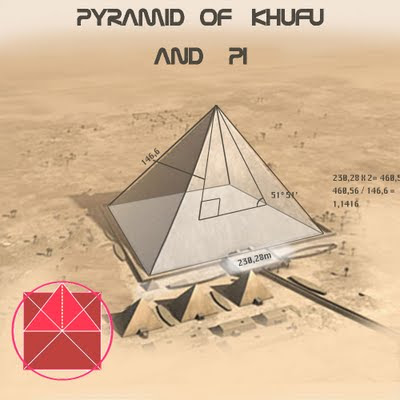 The pyramid of Cheops have a base length of 230,28 m, and a height of 146.6 m. If you take two times the base length, and divide this by the height, you get a value of Pi "3,14161..." the mathematical constant whose value is the ratio of any circle's circumference to its diameter;- Golden Ratio – Phi The pyramid of Cheops have a base length of 230,28 m, and a height of 146.6 m. If you take two times the base length, and divide this by the height, you get a value of Pi "3,14161..." the mathematical constant whose value is the ratio of any circle's circumference to its diameter;- Golden Ratio – Phi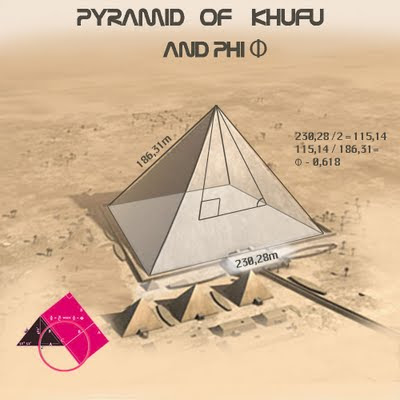 We could also find Golden Section (1:1.618), a unique ratio (or relationship between parts) that seems to be preferred by nature as the best geometry for growth, energy conservation, elegance and has some fundamental relationships to the platonic solids. Al we have to do is divide the length of the base (230.28m) by 2 and then divide it by the apothem (the altitude of a face, from ground to the top);- Center of Earth We could also find Golden Section (1:1.618), a unique ratio (or relationship between parts) that seems to be preferred by nature as the best geometry for growth, energy conservation, elegance and has some fundamental relationships to the platonic solids. Al we have to do is divide the length of the base (230.28m) by 2 and then divide it by the apothem (the altitude of a face, from ground to the top);- Center of Earth The Pyramid lies in the center of gravity of the continents. It also lies in the exact center of all the land area of the world, dividing the earth's land mass into approximately equal quarters.The north-south axis (31 degrees east of Greenwich) is the longest land meridian, and the east-west axis (30 degrees north) is the longest land parallel on the globe. There is obviously only one place that these longest land-lines of the terrestrial earth can cross, and it is at the Great Pyramid! This is incredible, one of the scores of features of this mighty structure which begs for a better explanation.- Perfectly placed stonesThe average casing stone on the lowest level was 5 ft. long by 5 ft. high by 6 ft. deep and weighed 15 tons. The casing stones weighing as much as 20 tons were placed with an accuracy of 5/1000ths of an inch, and an intentional gap of about 2/100ths of an inch for mortar;- From far awayHigh quality limestone was used for the outer casing, with some of the blocks weighing up to 15 tones. This limestone came from Tura, about 8 miles away on the other side of the Nile. Granite quarried nearly 500 miles away in Aswan with blocks weighing as much as 60-80 tones, was used for the portcullis doors and relieving chambers;- Chambers above ground levelThe Great Pyramid is the only pyramid to have chambers above ground level. The Pyramid lies in the center of gravity of the continents. It also lies in the exact center of all the land area of the world, dividing the earth's land mass into approximately equal quarters.The north-south axis (31 degrees east of Greenwich) is the longest land meridian, and the east-west axis (30 degrees north) is the longest land parallel on the globe. There is obviously only one place that these longest land-lines of the terrestrial earth can cross, and it is at the Great Pyramid! This is incredible, one of the scores of features of this mighty structure which begs for a better explanation.- Perfectly placed stonesThe average casing stone on the lowest level was 5 ft. long by 5 ft. high by 6 ft. deep and weighed 15 tons. The casing stones weighing as much as 20 tons were placed with an accuracy of 5/1000ths of an inch, and an intentional gap of about 2/100ths of an inch for mortar;- From far awayHigh quality limestone was used for the outer casing, with some of the blocks weighing up to 15 tones. This limestone came from Tura, about 8 miles away on the other side of the Nile. Granite quarried nearly 500 miles away in Aswan with blocks weighing as much as 60-80 tones, was used for the portcullis doors and relieving chambers;- Chambers above ground levelThe Great Pyramid is the only pyramid to have chambers above ground level. The arrangement of the pyramids is a disputed representation of the Orion constellation. Hancock and Bauval in their book explain that the ‘air’ shafts inside the Great Pyramid aligned to the stars in the Belt of Orion and the pole star around 2500 BC.  The southern shaft from the Queens Chamber aligned with the star Sirius at its culmination point on the meridian. This star was very important to the Egyptians and was associated with the mother Goddess Isis. The southern shaft emanating from the Kings Chamber aligned with the brightest star of the Orion Belt Zeta Orionis. This star was associated with the Egyptian God of resurrection and rebirth Osiris! The northern shafts aligned to the ancient pole star Alpha Draconis (Kings Chamber) and to Beta Ursa Minor (Queens Chamber);- Indicates equinoxes The southern shaft from the Queens Chamber aligned with the star Sirius at its culmination point on the meridian. This star was very important to the Egyptians and was associated with the mother Goddess Isis. The southern shaft emanating from the Kings Chamber aligned with the brightest star of the Orion Belt Zeta Orionis. This star was associated with the Egyptian God of resurrection and rebirth Osiris! The northern shafts aligned to the ancient pole star Alpha Draconis (Kings Chamber) and to Beta Ursa Minor (Queens Chamber);- Indicates equinoxes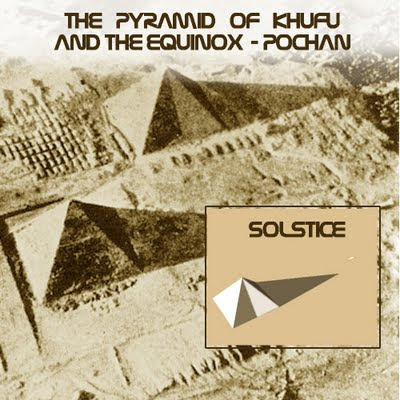 At dawn and sunset at the time of the equinoxes (around 21 March and 22 Sept), a shadow appears on the south face of the great pyramid, apparently dividing it in half, with the shaded side nearest the sun. The phenomenon occurs because the core-masonry is concave on all four faces by a yard deep. The casing stones that exist show clearly that the finished surface wasn't concave. This strange feature was first illustrated in La Description de l'Egypte in the late 1700's (Volume V, pl. 8). Flinders Petrie noticed a hollowing in the core masonry in the center of each face and wrote that he "continually observed that the courses of the core had dips of as much as ½° to 1°" (The Pyramids and Temples of Gizeh, 1883, p. 421). Though it is apparently more easily observed from the air, the concavity is measurable and is visible from the ground under favorable lighting conditions.- Pyramid power At dawn and sunset at the time of the equinoxes (around 21 March and 22 Sept), a shadow appears on the south face of the great pyramid, apparently dividing it in half, with the shaded side nearest the sun. The phenomenon occurs because the core-masonry is concave on all four faces by a yard deep. The casing stones that exist show clearly that the finished surface wasn't concave. This strange feature was first illustrated in La Description de l'Egypte in the late 1700's (Volume V, pl. 8). Flinders Petrie noticed a hollowing in the core masonry in the center of each face and wrote that he "continually observed that the courses of the core had dips of as much as ½° to 1°" (The Pyramids and Temples of Gizeh, 1883, p. 421). Though it is apparently more easily observed from the air, the concavity is measurable and is visible from the ground under favorable lighting conditions.- Pyramid power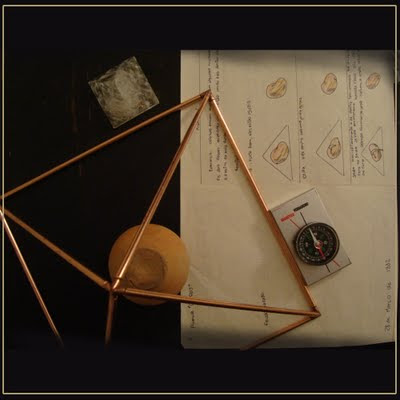
At the end of 70's Luiz Pagano father gifted him a cooper pyramidThere are many pseudoscientific theories in wich pyramids harnesses cosmic energy (or Universal Life Force Energy) and preserves it in its bosom. The idea that using small models of pyramids can improve health, improve the growth of seeds and plants, preserve food, sharpen or maintain the sharpness of razor blades, among others, was initiated in the 1930s by French hardware store owner and pendulum dowsing author Antoine Bovis.Pyramid should be oriented correctly with one of its face facing the north and the base should be perfectly aligned with the needle of a compass, Cosmic Energy gets more accumulated at 1/3rd height from the base of the Pyramid, the so called King's Chamber region.In 2005, an episode of MythBusters a test of pyramid power was performed, using pyramids built according to the specifications found in the Great Pyramid. Of course the show busted the myth, but strangely enough a half apple placed under the pyramid rots slower than the half they left in the open, force them to remake the experiment, and they didn’t perform the seed growth experiment (this one always worked in my tests as seen in my 1982 annotations caught on photo).There are lots and lots of pyramids in Egypt… And around the world:Pyramid of Chichen Itza in Mexico – one of the new 7 wonders of the World Mexico amazing historical Pyramid Chichen Itza was constructed by the pre-Columbian Maya someday among the 10th and 13th centuries AD, El Castillo served as a temple to the god Kukulkan, the Yucatec Maya Feathered Serpent deity carefully associated with the deity determine Quetzalcoatl identified to the Aztecs and different important Mexican cultures of the Postclassic period.Chichen Itza can be a step pyramid with a floor plan of squared terraces with stairways up each of the 4 facets to the temple on top. Nice sculptures of plumed serpents run down the edges of the northern staircase, and are set off by way of shadows from the nook stages at the spring and autumn equinoxes. Chichen Itza, this pyramid has 91 steps on 3 of the perimeters and 92 on the north staircase, which provides as much as 365 steps, or days of the year.The Mexican executive restored the pyramid in the 1920s and 1930s, concurrent with the Carnegie Establishment’s restoration of the Temple of Warriors. Archaeologists had been in a position to reconstruct two sides of this Chichen Itza pyramid in their entirety. Mexico amazing historical Pyramid Chichen Itza was constructed by the pre-Columbian Maya someday among the 10th and 13th centuries AD, El Castillo served as a temple to the god Kukulkan, the Yucatec Maya Feathered Serpent deity carefully associated with the deity determine Quetzalcoatl identified to the Aztecs and different important Mexican cultures of the Postclassic period.Chichen Itza can be a step pyramid with a floor plan of squared terraces with stairways up each of the 4 facets to the temple on top. Nice sculptures of plumed serpents run down the edges of the northern staircase, and are set off by way of shadows from the nook stages at the spring and autumn equinoxes. Chichen Itza, this pyramid has 91 steps on 3 of the perimeters and 92 on the north staircase, which provides as much as 365 steps, or days of the year.The Mexican executive restored the pyramid in the 1920s and 1930s, concurrent with the Carnegie Establishment’s restoration of the Temple of Warriors. Archaeologists had been in a position to reconstruct two sides of this Chichen Itza pyramid in their entirety.
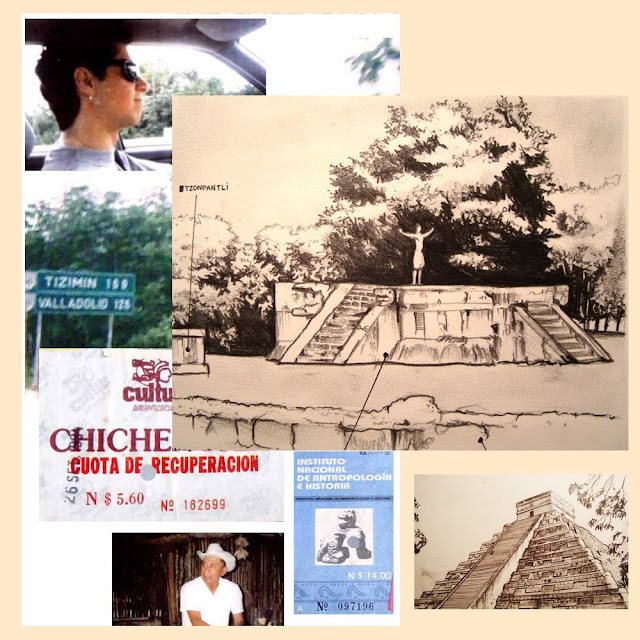 |
| Luiz Pagano travel to to Chichen Itza Sep/1994 |
Through digging from the top, they discovered another temple buried beneath the current one. Within the Chichen Itza temple chamber is a Chac Mool statue and a throne in the shape of jaguar, painted red with spots made from inlaid jade. The Mexican government excavated a tunnel from the base of the north staircase, up the in advance pyramid’s stairway to the hidden temple, and opened it to tourists.
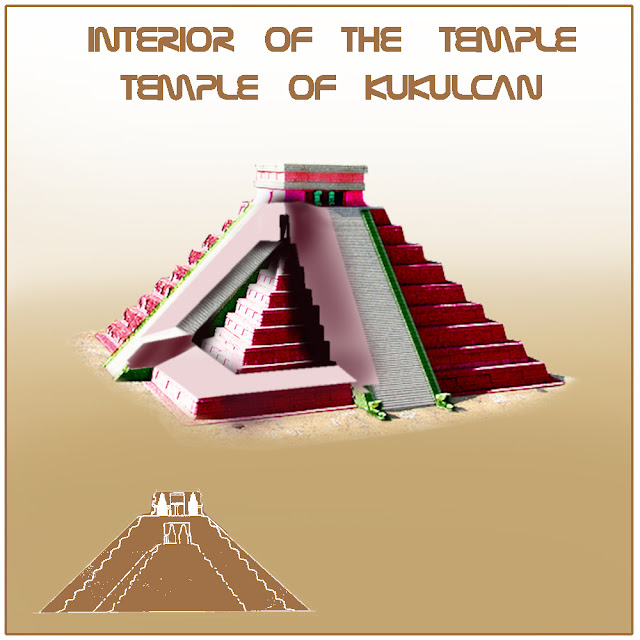 In up to date years, the National Institute of Anthropology and History (INAH), which manages the archaeological website online of Chichen Itza, has been final monuments to public access. At the same time as visitors can stroll round them, they may be able to no longer climb them or pass within their chambers. Mountaineering El Castillo used to be halted in 2006 after an 80-year old woman fell to her death. On the similar time INAH closed the general public access to the throne room.The staircases rise at an angle of 45 degrees to the horizontal, while the average inclination of the stepped pyramid itself is 53.3 degrees. The faces of the individual steps are sloped at a greater angle, approximately 73 degrees. The faces of the individual steps are sloped at a greater angle, approximately 73 degrees. - The nine main platforms of the pyramid are thought to represent the 18 months of the haab, and the 52 panels represent the number of years it takes for a calendar round date to recur.Height: 24m - top platform (+6m with the temple);The construction is 24 m high, the square base measures 55.3 m across;The temple at the top of the pyramid is 6 m high, 13.42 m wide, and 16.5 m long.The Pyramid of Kukulcan also has some facts imprinted on its structures:- The days of the yearEl Castillo's design is thought to relate to the Mayan calendar. Each of the four faces incorporates a broad, steep staircase consisting of 91 steps that ascends to the top platform. Counting the top platform as an additional step gives a total of 365 steps: 1step for each day of the year.- Indicates equinoxes - The nine main platforms of the pyramid are thought to represent the 18 months of the haab, and the 52 panels represent the number of years it takes for a calendar round date to recur.Height: 24m - top platform (+6m with the temple);The construction is 24 m high, the square base measures 55.3 m across;The temple at the top of the pyramid is 6 m high, 13.42 m wide, and 16.5 m long.The Pyramid of Kukulcan also has some facts imprinted on its structures:- The days of the yearEl Castillo's design is thought to relate to the Mayan calendar. Each of the four faces incorporates a broad, steep staircase consisting of 91 steps that ascends to the top platform. Counting the top platform as an additional step gives a total of 365 steps: 1step for each day of the year.- Indicates equinoxes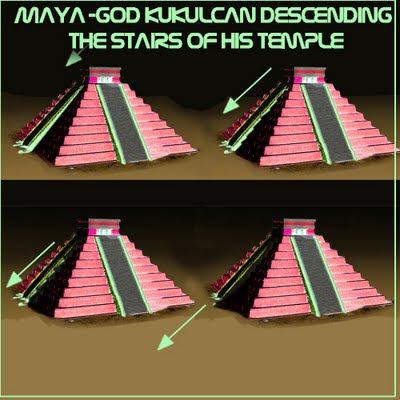 The shadow-serpent appear the slide down the steps of the north balustrade.The word for a snake's rattle, Tzab, is the same word for the Pleiades. In addition, research by Jose Diaz Bolio indicated that some Yucatecan rattlesnakes have a strange little three-dot marking in a circle near the rattlel. This symbol was read by Bolio as a solar ahau face, a symbol of the sun. Now, when the serpent shadow appears, if we wish to imagine the snake's tail, it must pierce the temple on top of the pyramid (the fifth, central direction-the zenith direction) and then it points up into the center of the sky (see diagram). Since the rattle is called tzab (Pleiades) and the three-dot ahau face design is the sun, the symbolism states unequivocally: sun and Pleiades in the zenith.This alignment doesn't occur on the equinoxes, but at Chichen Itza it occurs on May 20th in the 21st century. The point is that the pyramid "points", with this symbolism, to an astronomical alignment that occurs in a specific precessional era. As such, the Pyramid of Kukulcan is a precessional star clock constructed in stone.Pyramids of Louvre The shadow-serpent appear the slide down the steps of the north balustrade.The word for a snake's rattle, Tzab, is the same word for the Pleiades. In addition, research by Jose Diaz Bolio indicated that some Yucatecan rattlesnakes have a strange little three-dot marking in a circle near the rattlel. This symbol was read by Bolio as a solar ahau face, a symbol of the sun. Now, when the serpent shadow appears, if we wish to imagine the snake's tail, it must pierce the temple on top of the pyramid (the fifth, central direction-the zenith direction) and then it points up into the center of the sky (see diagram). Since the rattle is called tzab (Pleiades) and the three-dot ahau face design is the sun, the symbolism states unequivocally: sun and Pleiades in the zenith.This alignment doesn't occur on the equinoxes, but at Chichen Itza it occurs on May 20th in the 21st century. The point is that the pyramid "points", with this symbolism, to an astronomical alignment that occurs in a specific precessional era. As such, the Pyramid of Kukulcan is a precessional star clock constructed in stone.Pyramids of Louvre
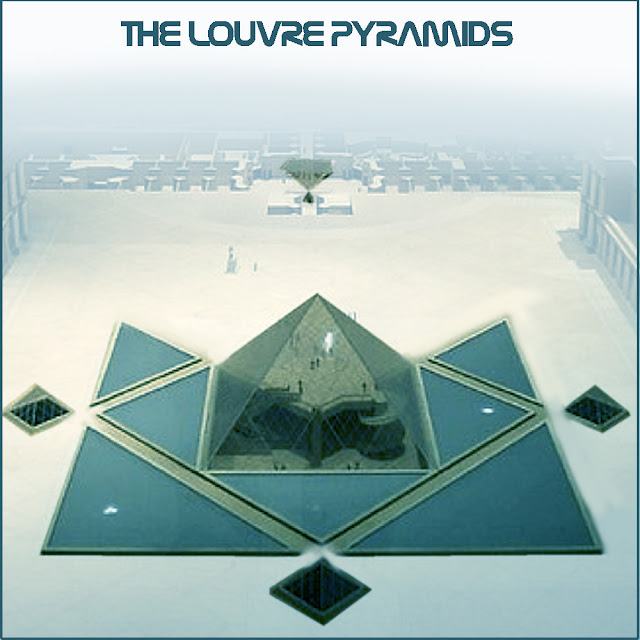 The third pyramid I would like to mention is the Louvre pyramid, a modern large glass and metal pyramid, surrounded by three smaller pyramids, in the main courtyard (Cour Napoléon) of the Louvre Palace. Was commissioned by the President of France François Mitterrand in 1984, it was designed by the architect I. M. Pei.The pyramid and the underground lobby beneath it were created because of a series of problems with the Louvre's original main entrance, which could no longer handle an enormous number of visitors on an everyday basis. Visitors entering through the pyramid descend into the spacious lobby then re-ascend into the main Louvre buildings. Several other museums have duplicated this concept, most notably the Museum of Science and Industry in Chicago.- Louvre Pyramides facts:The Louvre Pyramid is a pyramid with a square base.Height: 21.65 mLength of the base: 35 mTilt angle: 51.7 degrees;- The Legend of 666 windowsThis legend has its roots back in the 80s, when the official brochure was published, during its construction; it actually cited the number 666. But it was a mistaken number. The direction of the Louvre Museum confirmed that the complete pyramid has a total of 673 glass plates (603 diamonds and 70 triangles).David A. Shugart, in other hand, counts 689 3. It was made several statements, leading to varying results, all of them presenting more than 666; La Pyramide Inversée (The Inverted Pyramid) La Pyramide Inversée (The Inverted Pyramid) It is a magnificent skylight, considered a smaller sibling of the more famous Louvre Pyramid, yet turned upside down.The pyramid marks the intersection of two main walkways and orients visitors towards the museum entrance. Tensioned against a 30-ton, 13.3-meter square steel caisson frame, the inverted pyramidal shape in laminated glass points downward towards the floor. The tip of the pyramid is suspended 1.4 meters (a little more than 4.5 feet) above floor level. Individual glass panes in the pyramid, 30 mm thick, are connected by stainless-steel crosses 381 mm in length. After dark, the structure is illuminated by a frieze of spotlights.Directly below the tip of the downwards-pointing glass pyramid, a small stone pyramid (about one meter/three feet high) is stationed on the floor, as if mirroring the larger structure above: The tips of the two pyramids almost touch. It is a magnificent skylight, considered a smaller sibling of the more famous Louvre Pyramid, yet turned upside down.The pyramid marks the intersection of two main walkways and orients visitors towards the museum entrance. Tensioned against a 30-ton, 13.3-meter square steel caisson frame, the inverted pyramidal shape in laminated glass points downward towards the floor. The tip of the pyramid is suspended 1.4 meters (a little more than 4.5 feet) above floor level. Individual glass panes in the pyramid, 30 mm thick, are connected by stainless-steel crosses 381 mm in length. After dark, the structure is illuminated by a frieze of spotlights.Directly below the tip of the downwards-pointing glass pyramid, a small stone pyramid (about one meter/three feet high) is stationed on the floor, as if mirroring the larger structure above: The tips of the two pyramids almost touch. Brown was not the first writer to offer esoteric interpretations of the Inverted Pyramid. In Raphaël Aurillac's work Le guide du Paris maçonnique the author declares that the Louvre used to be a Masonic temple. To Aurillac, the various glass pyramids constructed in recent decades include Masonic symbolism. Aurillac sees the downward-pointing pyramid as expressing the Rosicrucian motto V.I.T.R.I.O.L. (Visita Interiorem Terrae Rectificandoque / Invenies Occultum Lapidem, "Visit the interior of the earth and… you will find the secret stone"). Another writer on Masonic architecture, Dominique Setzepfandt, sees the two pyramids as suggesting "the compass and square that together form the Seal of Solomon" (quoted in Code Da Vinci: L'enquête by Marie-France Etchegoin and Frédéric Lenoir), Brown was not the first writer to offer esoteric interpretations of the Inverted Pyramid. In Raphaël Aurillac's work Le guide du Paris maçonnique the author declares that the Louvre used to be a Masonic temple. To Aurillac, the various glass pyramids constructed in recent decades include Masonic symbolism. Aurillac sees the downward-pointing pyramid as expressing the Rosicrucian motto V.I.T.R.I.O.L. (Visita Interiorem Terrae Rectificandoque / Invenies Occultum Lapidem, "Visit the interior of the earth and… you will find the secret stone"). Another writer on Masonic architecture, Dominique Setzepfandt, sees the two pyramids as suggesting "the compass and square that together form the Seal of Solomon" (quoted in Code Da Vinci: L'enquête by Marie-France Etchegoin and Frédéric Lenoir),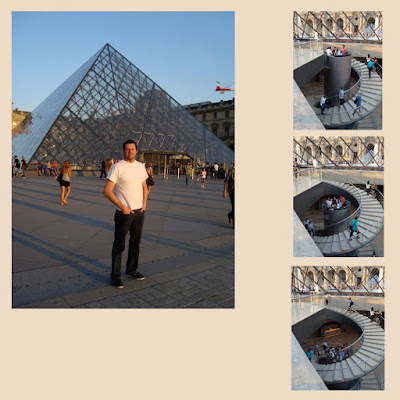
Luiz Pagano at Louvre Aug 2010Whether it is built to consolidate power of the Pharaoh or to accumulate the energy of the universe, fact is that the pyramids will be always related as a symbol of mystery and power of our planet.
EVERYTHING IS CONNECTED AND THERE ARE NO COINCIDENCES
|
|
|
|
|
John 1:1-2:1 symbolize the first week of creation which ended on the 7th day with the wedding of Adam and Eve. John's week ends with the wedding in Cana.
| Day #1 |
1:23-28 "This was the witness of John, when the Jews sent to him priests and Levites from Jerusalem..." "This happened at Bethany, on the far side of the Jordan, where John was baptizing." |
| Day #2 |
1:29-34 "The next day..." "I have seen and I testify that he is the Son of God." |
| Day #3 |
1:35-42 "The next day..." "You Simon son of John; you are to be called Cephas-which means Rock." |
| Day #4 |
1:43-51 "The next day..." "...you will see heaven open and the angels of God ascending and descending over the Son of man." |
| Day #5-6 |
|
| Day #7 |
2:1 "On the third day"...[from the last day which was day 4] there was a wedding at Cana in Galilee." |
Michal Hunt, Copyright © 2003 Agape Bible Study. Permissions All Rights Reserved.
Jesus identifies Himself with the significant and symbolic words: I AM, ego ami, which reminds us of Yahweh's revelation of Himself to Moses3 times as I AM in Exodus 3:13-14. In John's Gospel Jesus will use these words 26 times and in 7 different metaphors [each used with a predicate nominative]:
| 1. 6:35 |
"I AM the bread of life" |
| 2. 8:12 |
"I AM the light of the world" |
| 3. 10:7 |
"I AM the gate for the sheep" |
| 4. 10:11 |
"I AM the good shepherd" |
| 5. 11:25 |
"I AM the resurrection and the life" |
| 6. 14:6 |
"I AM the way and the truth and the life" |
| 7. 15:1 |
"I AM the true vine" |
Michal Hunt, Copyright © 2003 Agape Bible Study. Permissions All Rights Reserved.
St. John will also record four "I AM" statements in which Jesus does not use a predicate nominative:
| "I AM" with predicate nominative |
"I AM" without predicate nominative |
| 1. 6:35 |
"I AM the bread of life" |
1. 8:24 |
"...if you do not believe that I AM, you will die in your sins." |
| 2. 8:12 |
"I AM the light of the world" |
2. 8:28 |
When you have lifted up the Son of man, then you will know that I AM (He)* |
| 3. 10:7 |
"I AM the gate for the sheep" |
3. 8:58 |
"In all truth (Amen, amen) I tell you, before Abraham ever was, I AM." |
| 4. 10:11 |
"I AM the good shepherd" |
4. 13:19 |
"I tell you this now, before it happens, so that when it does happen you may believe that I AM (He)*" |
| 5. 11:25 |
"I AM the resurrection and the life" |
|
| 6. 14:6 |
"I AM the way and the truth and the life" |
|
| 7. 15:1 |
"I AM the true vine" |
|
|
|
|
|
|
word 'vatican' comes from Latin and is a contraction of two words in the following way:
'Vatis' = 'profetic' or 'diviner' 'Can' = 'serpent/snake'
These two words combined make:
'the profetic- or made devine serpent'
The Vatican is a place, so you may say, that 'Vatican' means 'the place of the profetic- and worshipped serpent'.
Trying to translate 'divining serpent' into every-day-English I would say it means:
'A spiritual serpent that is worshipped as god'.
Vatican the holy place of babylon..
VATIC : Prophet
CAN: Serpent |
|
|
|
|
Pope Francis Hosts Feathered Serpent God As Part Of Deity Exchange Program
Published:
September 9, 2016
VATICAN CITY—In an effort to strengthen their relationship and foster interfaith dialogue, Pope Francis reportedly welcomed the winged Mayan snake god Kukulkan to the Vatican this week as part of a month-long deity exchange program. “We are excited to have the War Serpent staying here with us for the next four weeks, during which time he’ll be exposed to the rituals and customs of the Catholic Church, so that when he returns home he can share the experience with his adherents in Chichén Itzá and the surrounding Yucután communities,” said Vatican spokesperson Greg Burke, noting that the pontiff had taken Kukulkan out for pizza on the first night of the exchange before showing him around some of Rome’s most famous landmarks. “Once Kukulkan gets settled in, the pope plans to let him answer some basic prayers on his own, as well as try performing a transubstantiation or two. And perhaps toward the end of his stay, if he’s feeling up to it, Kukulkan can treat us all to an authentic human sacrifice.” Vatican sources confirmed that as part of the exchange, God Almighty, Our Heavenly Father, would be spending the next month with the Taoist thunder god Lei Gong in the cloud kingdom over Tibet.
https://theonion.com/pope-francis-hosts-feathered-serpent-god-as-part-of-dei-1819579199/ |
|
|
|
|
Arqueólogos desenterraron mercurio líquido bajo las antiguas pirámides de Teotihuacán en México. ¿Por qué razón estaba ahí?
. . .
Arqueólogos anunciaron recientemente el descubrimiento de “grandes cantidades” de mercurio en la entrada de una cámara funeraria a sesenta pies por debajo de la ciudad pre-azteca de Teotihuacan. El hallazgo es un desarrollo reciente en una excavación de seis años de las ruinas de la Pirámide de la Serpiente Emplumada. Hasta ahora, los túneles sagrados han producido alrededor de 50.000 artefactos, como esculturas de piedra y cuchillos de obsidiana; sin embargo, el mercurio puede ser la clave para descubrir un misterio aún mayor.

Vía Reuters:
Algunos arqueólogos creen que el elemento tóxico podría presagiar lo que sería la primera tumba de un gobernante jamás encontrada en Teotihuacán, un contemporáneo de varias ciudades mayas antiguas, pero tan envuelto en misterio que sus habitantes aún no tienen nombre.
¿Por qué los miembros de la realeza podrían colocar sus tumbas alrededor de mercurio? El arqueólogo principal Sergio Gómez tiene una teoría sobre las pirámides de Teotihuacan.
Sin estar seguro de por qué se colocó el mercurio allí, Gómez dice que el metal pudo haber sido usado para simbolizar un río o lago del inframundo. Anteriormente descubierto en pequeñas cantidades en algunos sitios mayas mucho más al sur, nunca se había encontrado en Teotihuacan.

Recordemos que el mismo dios romano Mercurio, patrón de oradores, viajeros y comerciantes, es también un psicopompo, un dios encargado de llevar las almas al más allá. El elemento Mercurio también se ha encontrado en tumbas egipcias y se rumorea que rodea la necrópolis subterránea del emperador chino Qín Shǐ Huáng Dì. La naturaleza “inmortal” de Mercurio también fue apreciada por los primeros alquimistas modernos y a menudo se alude a ella en sus referencias a la piedra filosofal.
Aunque el vínculo entre el mercurio en otras culturas y las costumbres mesoamericanas es completamente coincidente, probablemente haya una razón simple por la que el elemento fue tan favorecido por la alta sociedad: simplemente fue difícil de encontrar.
Difícil de extraer y apreciado por sus propiedades reflectantes, el mercurio era raro en el México antiguo. Los arqueólogos creen que pudo haberle dado un significado sobrenatural para fines rituales.
Todas las personas no podían permitirse rodear su cadáver y sus riquezas con ríos de metal líquido. Para los antiguos, pudo haber sido el símbolo perfecto del abismo acuático del inframundo, una barrera entre la tierra de los vivos y la tierra de los muertos.
https://mxc.com.mx/2020/09/17/por-que-hay-mercurio-liquido-debajo-de-las-piramides-de-teotihuacan/ |
|
|
|
|
Hagia Sophia
From Wikipedia, the free encyclopedia
Hagia Sophia (Turkish: Ayasofya; Ancient Greek: Ἁγία Σοφία, romanized: Hagía Sophía; Latin: Sancta Sapientia; lit. 'Holy Wisdom'), officially the Hagia Sophia Grand Mosque (Turkish: Ayasofya-i Kebir Cami-i Şerifi; Greek: Μεγάλο Τζαμί της Αγίας Σοφίας),[3] is a mosque and former church serving as a major cultural and historical site in Istanbul, Turkey. The last of three church buildings to be successively erected on the site by the Eastern Roman Empire, it was completed in AD 537. The site was an Eastern rite church from AD 360 to 1453, except for a brief time as a Latin Catholic church between the Fourth Crusade and 1261.[4] After the fall of Constantinople in 1453, it served as a mosque until 1935, when it became a museum. In 2020, the site once again became a mosque.
The current structure was built by the Byzantine emperor Justinian I as the Christian cathedral of Constantinople for the Byzantine Empire between 532 and 537, and was designed by the Greek geometers Isidore of Miletus and Anthemius of Tralles.[5] It was formally called the Church of God's Holy Wisdom (Greek: Ναὸς τῆς Ἁγίας τοῦ Θεοῦ Σοφίας, romanized: Naòs tês Hagías toû Theoû Sophías)[6][7] and upon completion became the world's largest interior space and among the first to employ a fully pendentive dome. It is considered the epitome of Byzantine architecture[8] and is said to have "changed the history of architecture".[9] The present Justinianic building was the third church of the same name to occupy the site, as the prior one had been destroyed in the Nika riots. As the episcopal see of the ecumenical patriarch of Constantinople, it remained the world's largest cathedral for nearly a thousand years, until the Seville Cathedral was completed in 1520. Beginning with subsequent Byzantine architecture, Hagia Sophia became the paradigmatic Orthodox church form, and its architectural style was emulated by Ottoman mosques a thousand years later.[10] It has been described as "holding a unique position in the Christian world"[10] and as an architectural and cultural icon of Byzantine and Eastern Orthodox civilization.[10][11][12]
The religious and spiritual centre of the Eastern Orthodox Church for nearly one thousand years, the church was dedicated to the Holy Wisdom.[13][14][15] It was where the excommunication of Patriarch Michael I Cerularius was officially delivered by Humbert of Silva Candida, the envoy of Pope Leo IX in 1054, an act considered the start of the East–West Schism. In 1204, it was converted during the Fourth Crusade into a Catholic cathedral under the Latin Empire, before being returned to the Eastern Orthodox Church upon the restoration of the Byzantine Empire in 1261. Enrico Dandolo, the doge of Venice who led the Fourth Crusade and the 1204 Sack of Constantinople, was buried in the church.
After the fall of Constantinople to the Ottoman Empire in 1453,[16] it was converted to a mosque by Mehmed the Conqueror and became the principal mosque of Istanbul until the 1616 construction of the Sultan Ahmed Mosque.[17][18] Upon its conversion, the bells, altar, iconostasis, ambo, and baptistery were removed, while iconography, such as the mosaic depictions of Jesus, Mary, Christian saints and angels were removed or plastered over.[19] Islamic architectural additions included four minarets, a minbar and a mihrab. The Byzantine architecture of the Hagia Sophia served as inspiration for many other religious buildings including the Hagia Sophia in Thessaloniki, Panagia Ekatontapiliani, the Şehzade Mosque, the Süleymaniye Mosque, the Rüstem Pasha Mosque and the Kılıç Ali Pasha Complex. The patriarchate moved to the Church of the Holy Apostles, which became the city's cathedral.
The complex remained a mosque until 1931, when it was closed to the public for four years. It was re-opened in 1935 as a museum under the secular Republic of Turkey, and the building was Turkey's most visited tourist attraction as of 2019.[20]
In July 2020, the Council of State annulled the 1934 decision to establish the museum, and the Hagia Sophia was reclassified as a mosque. The 1934 decree was ruled to be unlawful under both Ottoman and Turkish law as Hagia Sophia's waqf, endowed by Sultan Mehmed, had designated the site a mosque; proponents of the decision argued the Hagia Sophia was the personal property of the sultan. The decision to designate Hagia Sophia as a mosque was highly controversial. It resulted in divided opinions and drew condemnation from the Turkish opposition, UNESCO, the World Council of Churches and the International Association of Byzantine Studies, as well as numerous international leaders, while several Muslim leaders in Turkey and other countries welcomed its conversion into a mosque.
Church of Constantius II
[edit]
 Hagia Sophia, Istanbul, Turkey, ca. 1897.
The first church on the site was known as the Magna Ecclesia (Μεγάλη Ἐκκλησία, Megálē Ekklēsíā, 'Great Church')[21][22] because of its size compared to the sizes of the contemporary churches in the city.[13] According to the Chronicon Paschale, the church was consecrated on 15 February 360, during the reign of the emperor Constantius II (r. 337–361) by the Arian bishop Eudoxius of Antioch.[23][24] It was built next to the area where the Great Palace was being developed. According to the 5th-century ecclesiastical historian Socrates of Constantinople, the emperor Constantius had c. 346 "constructed the Great Church alongside that called Irene which because it was too small, the emperor's father [Constantine] had enlarged and beautified".[25][23] A tradition which is not older than the 7th or 8th century reports that the edifice was built by Constantius' father, Constantine the Great (r. 306–337).[23] Hesychius of Miletus wrote that Constantine built Hagia Sophia with a wooden roof and removed 427 (mostly pagan) statues from the site.[26] The 12th-century chronicler Joannes Zonaras reconciles the two opinions, writing that Constantius had repaired the edifice consecrated by Eusebius of Nicomedia, after it had collapsed.[23] Since Eusebius was the bishop of Constantinople from 339 to 341, and Constantine died in 337, it seems that the first church was erected by Constantius.[23]
 View of the dome interior
        |
|
|
|
|
 Primer Primer  Anterior 2 a 3 de 3 Siguiente Anterior 2 a 3 de 3 Siguiente  Último Último  |
|
|
|
 Primer Primer
 Anterior
215 a 229 de 229
Siguiente Anterior
215 a 229 de 229
Siguiente
 Último
Último

|

































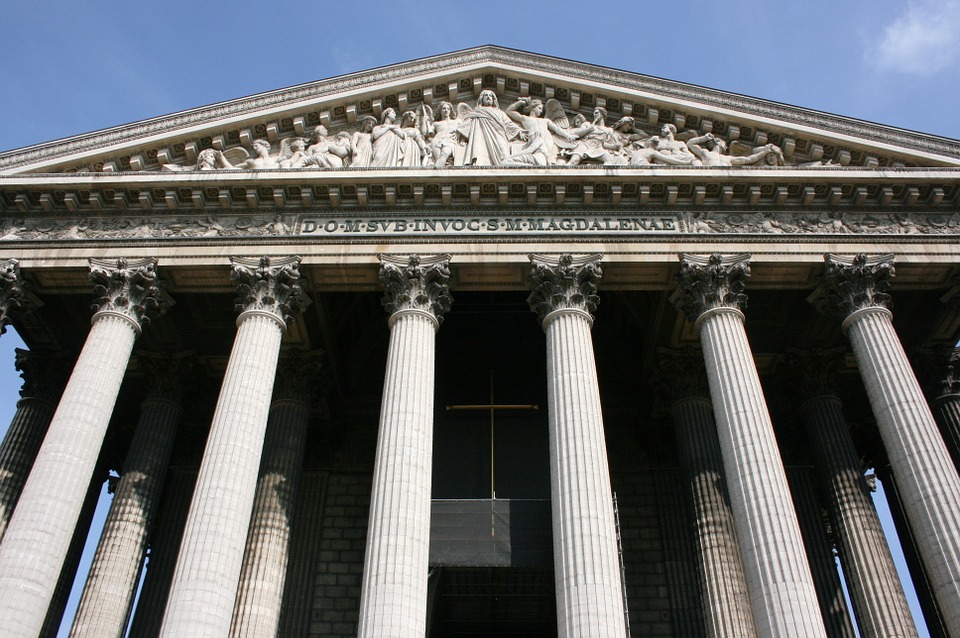
![PDF] Applying Golden Ratio in Product Packaging and Its Effect on Consumer ' s Buying Behaviour | Semantic Scholar](https://d3i71xaburhd42.cloudfront.net/c165da18263b580ae561090171c166c8fa054a6a/3-Figure1-1.png)






![The Pantheon and the golden rectangle [49] | Download Scientific Diagram](https://www.researchgate.net/publication/350876518/figure/fig2/AS:1012713207631873@1618461052910/The-Pantheon-and-the-golden-rectangle-49.png)



















